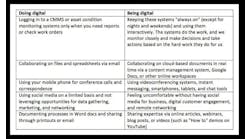Three trends in connecting industrial workers
By Conrad Hofmeyr, CEO and co-founder of JourneyApps
Using the IIoT and digital field apps to connect workers is increasingly becoming a strategic imperative for industrial companies, particularly with oil & gas, mining & metals, chemicals, utilities and manufacturing.
The aim is to reduce the isolation of remote field workers by better connecting them to the information, workflows and coworkers that enable them to complete jobs more efficiently.
JourneyApps' Conrad Hofmeyr
Connecting workers increases the flow of information in field operations exponentially—creating better visibility for both the back office and customers.
Let’s explore some trends that are emerging as companies rush to connect field workers:
1. Putting streaming IIoT data directly in the hands of connected workers
We are seeing a trend toward incorporating streaming telemetry data from assets into digital field applications. Typically, telemetry data can only be viewed on-site, normally through a Windows desktop application. Companies are increasingly making this data available on mobile devices in the field, which puts information in the hands of field workers, enabling proactive, corrective actions to be taken much faster in the case of irregularities or underperformance of assets.
MQTT is one of the important technologies in this area—it is quickly becoming the preferred protocol for the IIoT. One way to put IIoT data in the hands of field workers is to stream telemetry data from assets using MQTT and consuming the streams in a Microsoft Power BI real-time dashboard that is embedded within an app.
2. Making IIoT exception alerts more actionable in the field
Once streaming telemetry data is available to users in the field, the insights gained from the data need to be actionable. This means that IIoT data and alerts need to be integrated directly into the workflows of digital field apps.
Consider the following scenario: an expert operator is remotely monitoring telemetry data for 20 oil rigs. The operator notices something askew and creates an alert. There are a few steps that need to take place:
- The alert needs to be assigned to a technician.
- The technician needs to be alerted by a push notification or a text message. Alerts can even show up on wearable devices, such as an Apple Watch.
- The alert needs to be acknowledged by the recipient.
- Unacknowledged alerts need to be escalated up the chain of command.
In most of the IIoT installations in place today, this digital loop does not exist. Or it has been “duct taped” together with a brittle patchwork of systems. To achieve the full potential of connecting workers, companies on the forefront of innovation are working to create a strong linkage between IIoT alerts and field workflows.
3. Cloud & edge computing working together
In the past decade, there has been a massive effort to move data and systems to the cloud. However, in the remote settings where industrial field workers typically find themselves, internet connectivity is often either unavailable or highly constrained. Industrial companies typically establish a local area network (LAN) on a remote site such as an oil rig or mine shaft, enabling local network communication on-site.
As field operations become increasingly digital, this divide between the “cloud and the edge” needs to be bridged—as a result, companies are putting a greater focus on store-and-forward data architectures where data is available on the LAN in real-time and synced with a consolidated cloud database asynchronously.
Furthermore, there is a trend toward moving application logic to execute on the “edge”—i.e. on the client-side instead of in the cloud. Benefits include enhanced computing performance, the ability to connect to other LAN services for snappy local integrations, and the ability to execute work offline without connectivity.
So what does this all mean?
The most innovative industrial companies are getting closer and closer to fully connecting their remote personnel. By harnessing the full power of IIoT and edge computing using purpose-built field apps, they are turning the vision of the fully connected, fully optimized field worker into a reality.




